As I have so often mentioned in this blog, I buy and/or receive far too many books to review, in spite of my good (and astoundingly naive) intentions. In an effort to shine a spotlight on the new arrivals, and assuage my guilt, I am starting a new feature on 32 Pages – Shelf Landings – to briefly introduce the literary lovelies that have wandered, teased, coerced, and/or otherwise charmed their way into my life. It is also my intention to say a few words about the provenance of each book – how it came to my attention, especially in cases where my fellow crack addicts, I mean, children’s literature aficionado’s, have inspired my choices. Most will be picture books, but not all. Some will get full reviews another day, and others will inflict guilt as they languish on my shelves – loved, but unreviewed. Depending the number of bookstore visits, and the (highly variable) depths of my pockets, Shelf Landings will be posted several times each month, in addition to the regular full reviews, but brace yourself, this inaugural post is valued packed with fantastic new(ish) books not just from the last week, but the last six months. The first step is admitting it, right?
 The Promise (Nicola Davies, Laura Carlin/Candlewick Press) This book will be my next full review, and it’s a beauty. Kind of a Johnny Appleseed for the 21st Century, The Promise is set in a bleak, industrial landscape wiped of colour, where everyone is mean and ugly – a reflection of their environment. A young girl snatches a bag from an old woman, who makes her promise to plant the acorn seeds within. Initially disappointed that the bag did not contain money or food, the girl soon realizes the seeds are a gift of incomprehensible magnitude. “I held a forest in my arms, and my heart was changed.” I LOVE stories about the transformative power of nature, and this book delivers on every level. It is glorious. I’m looking forward to diving even deeper in the coming days.
The Promise (Nicola Davies, Laura Carlin/Candlewick Press) This book will be my next full review, and it’s a beauty. Kind of a Johnny Appleseed for the 21st Century, The Promise is set in a bleak, industrial landscape wiped of colour, where everyone is mean and ugly – a reflection of their environment. A young girl snatches a bag from an old woman, who makes her promise to plant the acorn seeds within. Initially disappointed that the bag did not contain money or food, the girl soon realizes the seeds are a gift of incomprehensible magnitude. “I held a forest in my arms, and my heart was changed.” I LOVE stories about the transformative power of nature, and this book delivers on every level. It is glorious. I’m looking forward to diving even deeper in the coming days.
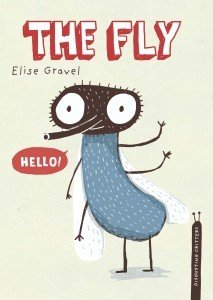 Also queued up for imminent (full) review, the delightful Disgusting Critters series by Governor General Award winning illustrator Elise Gravel (Tundra Books.) Currently, I have The Worm, and The Fly, but hope to add to my collection as each new title is published (upcoming, The
Also queued up for imminent (full) review, the delightful Disgusting Critters series by Governor General Award winning illustrator Elise Gravel (Tundra Books.) Currently, I have The Worm, and The Fly, but hope to add to my collection as each new title is published (upcoming, The  Slug and The Rat.) Unfailingly cheerful and fabulously gross, these little books are absolute gems of fun facts and wonderfully quirky illustration. I wish I had these books when I was a kid. Not only do they educate, they do it in the most artful and interesting way. As players in their own story, the fly and the worm respectively comment on, or act out the information provided, as in a sequence where a young fly learns to regurgitate his food: “There’s a good boy!” Tons of fun.
Slug and The Rat.) Unfailingly cheerful and fabulously gross, these little books are absolute gems of fun facts and wonderfully quirky illustration. I wish I had these books when I was a kid. Not only do they educate, they do it in the most artful and interesting way. As players in their own story, the fly and the worm respectively comment on, or act out the information provided, as in a sequence where a young fly learns to regurgitate his food: “There’s a good boy!” Tons of fun.
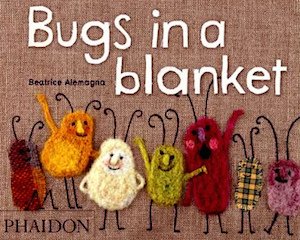 Keeping with the theme of insects, or buggery to be more precise, I am fascinated by the fabric illustration of Beatrice Alemagna. Bugs in a Blanket (Phaidon, 2009) and Bugs in the Garden (Phaidon, 2011) are tremendously engaging books about a family of bed bugs living in a discarded mattress. Hard to imagine a more despised sub-category of insect, but in Alemagna’s hands, they are the sweetest, funniest, jolliest bunch of critters to ever infest a blanket.
Keeping with the theme of insects, or buggery to be more precise, I am fascinated by the fabric illustration of Beatrice Alemagna. Bugs in a Blanket (Phaidon, 2009) and Bugs in the Garden (Phaidon, 2011) are tremendously engaging books about a family of bed bugs living in a discarded mattress. Hard to imagine a more despised sub-category of insect, but in Alemagna’s hands, they are the sweetest, funniest, jolliest bunch of critters to ever infest a blanket.
In the original book of the series, Bugs in a Blanket, the bugs meet for the first time. Little Fat Bug is surprised to learn that none of the other bugs are fat, or white. Bringing diversity to the bug world is a great way of flexing Alemagna’s artistic skills while making a subtle point about acceptance. Using wool and felt, she creates fantastically original characters, all of whom share one feature – a pendulous nose. In Bugs in the Garden, the bugs move beyond the blanket and into  the garden where they face their fears of the unknown and make new friends with a giant louse (among others.) I will admit that it is strange to read Alemagna’s books about bed bugs and think, if only briefly, how nice it would be to have these guys around! I attribute this, in part, to my pathological inclination toward anthropomorphism, but in fact it is about superb storytelling and the sort of illustration that puts exceedingly cute faces on tiny things. The other books in this series include The Bug Next Door, and Bugs at Christmas. More about her unusual illustration technique here.
the garden where they face their fears of the unknown and make new friends with a giant louse (among others.) I will admit that it is strange to read Alemagna’s books about bed bugs and think, if only briefly, how nice it would be to have these guys around! I attribute this, in part, to my pathological inclination toward anthropomorphism, but in fact it is about superb storytelling and the sort of illustration that puts exceedingly cute faces on tiny things. The other books in this series include The Bug Next Door, and Bugs at Christmas. More about her unusual illustration technique here.
 Some covers are love at first sight. When I bought Rabbityness (Jo Empson/Child’s Play) a few months ago, we were in the middle of a dreary spring, and the Pollockesque spray of colour on the cover was like a summer day in March. Also, the title – Rabbityness? Wonderful. In the first few pages, we learn that Rabbit likes doing all the usual rabbity things, but he also likes to paint, and make music. Doing what comes naturally makes this creative rabbit very happy, and his wildly colourful forest paintings and didgeridoo musical compositions make all the other rabbits happy too. Alas, the Rabbit disappears, but leaves the tools of his artistic trade in his hole, inspiring those left behind. Rabbityness is lively, beautiful, and in some places a little sad, but ultimately, it is a celebration of individualism and creativity. As far as I know, there are no artsy fartsy rabbits in my neighbourhood (they’re mostly gardeners), but I’m gonna leave some paint out and see what happens. For other children’s picture books about art, check out Seasonal & Themed (under Books About Painting) on 32 Pages.
Some covers are love at first sight. When I bought Rabbityness (Jo Empson/Child’s Play) a few months ago, we were in the middle of a dreary spring, and the Pollockesque spray of colour on the cover was like a summer day in March. Also, the title – Rabbityness? Wonderful. In the first few pages, we learn that Rabbit likes doing all the usual rabbity things, but he also likes to paint, and make music. Doing what comes naturally makes this creative rabbit very happy, and his wildly colourful forest paintings and didgeridoo musical compositions make all the other rabbits happy too. Alas, the Rabbit disappears, but leaves the tools of his artistic trade in his hole, inspiring those left behind. Rabbityness is lively, beautiful, and in some places a little sad, but ultimately, it is a celebration of individualism and creativity. As far as I know, there are no artsy fartsy rabbits in my neighbourhood (they’re mostly gardeners), but I’m gonna leave some paint out and see what happens. For other children’s picture books about art, check out Seasonal & Themed (under Books About Painting) on 32 Pages.
Dream Dog by Lou Berger and David Catrow (Schwartz & Wade Book, 2013) is exactly that – a book about an imaginary dog, but try telling that to young Harry. More than anything, Harry wants a dog, but his father  works in a pepper factory which has made his nose sensitive, especially to dogs, so by way of appeasement, he gets his son a chameleon. I speak from experience when I say, if you want a Mars Bar, a carrot is a poor second cousin. Several dogless days later, Harry puts on his X-35 Infra-Rocket Imagination Helmet and conjures up a spectacular, cloud-like dog, who he names Waffle. Harry and Waffle become inseparable, until a change of paternal employment allows a real dog to come into Harry’s life. In Dream Dog, and in every other book by David Catrow, the illustrations are infused with kid energy: hyperactive, good humoured, and in every way, dazzling. Lou Berger’s lively and warm-hearted words are perfect jumping off points for Catrow’s wild artistic imagination. These two, like a dog and a kid, are made for each other. A longer review to follow.
works in a pepper factory which has made his nose sensitive, especially to dogs, so by way of appeasement, he gets his son a chameleon. I speak from experience when I say, if you want a Mars Bar, a carrot is a poor second cousin. Several dogless days later, Harry puts on his X-35 Infra-Rocket Imagination Helmet and conjures up a spectacular, cloud-like dog, who he names Waffle. Harry and Waffle become inseparable, until a change of paternal employment allows a real dog to come into Harry’s life. In Dream Dog, and in every other book by David Catrow, the illustrations are infused with kid energy: hyperactive, good humoured, and in every way, dazzling. Lou Berger’s lively and warm-hearted words are perfect jumping off points for Catrow’s wild artistic imagination. These two, like a dog and a kid, are made for each other. A longer review to follow.
 Time For Bed, Fred! (Yasmeen Ismail/Bloomsbury, 2014) is also a book about a dog, but unlike Waffle, this one is playfully disobedient. With simple, repetitive phrases, Time For Bed, Fred! is clearly aimed at a younger audience, but the gorgeous illustrations will appeal to young and old alike. In fact, speaking as an oldy oldenstein, Time For Bed, Fred! is a throwback to older illustration styles, with loosely drawn, boldly placed imagery front and centre on the page. No background, nor is it needed. Fred is the star, and Yasmeen Ismail wastes no space on extraneous detail. I’m not entirely sure how I first became aware of this book, but I do know that a certain two-page illustration – a scene of Fred hiding in flowers, inspired an immediate purchase. “Fred? That’s not your bed, Fred!” It’s truly stunning. I can imagine a parent or teacher reading this book to a giggling child, while the beautiful images subtly imprint themselves, remembered later, with deep fondness.
Time For Bed, Fred! (Yasmeen Ismail/Bloomsbury, 2014) is also a book about a dog, but unlike Waffle, this one is playfully disobedient. With simple, repetitive phrases, Time For Bed, Fred! is clearly aimed at a younger audience, but the gorgeous illustrations will appeal to young and old alike. In fact, speaking as an oldy oldenstein, Time For Bed, Fred! is a throwback to older illustration styles, with loosely drawn, boldly placed imagery front and centre on the page. No background, nor is it needed. Fred is the star, and Yasmeen Ismail wastes no space on extraneous detail. I’m not entirely sure how I first became aware of this book, but I do know that a certain two-page illustration – a scene of Fred hiding in flowers, inspired an immediate purchase. “Fred? That’s not your bed, Fred!” It’s truly stunning. I can imagine a parent or teacher reading this book to a giggling child, while the beautiful images subtly imprint themselves, remembered later, with deep fondness.
This is how it happens. I saw Warning: Do Not Open This Book (Adam Lehrhaupt, Matthew Forsythe/Simon & Schuster) in a store. I was trying to be ‘good’, so I took a photo of the book, gave myself an imaginary pat on the back,  and vowed to pick it up later. You know, months later, when the stacks of books in my home were not so high, and my bank account not so low. A few days passed, I saw the book in another store, and out came my wallet. This is how it happens.
and vowed to pick it up later. You know, months later, when the stacks of books in my home were not so high, and my bank account not so low. A few days passed, I saw the book in another store, and out came my wallet. This is how it happens.
I blame it on the monkeys. In Warning: Do Not Open This Book, the narrator talks directly to the reader. Of course, I paid him no heed and opened the book, and of course, the monkeys got out. From chimpanzee to madrill (and one fabulous guy with a long nose and grinning teeth), the monkeys spill on to the page, later joined by a flock of toucans. It’s not all monkey business, however. Sporting guitars and cans of paint, these pop-eyed fellows create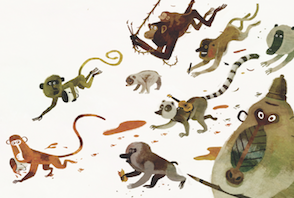 their own world, painting the vines and trees on which to swing, sit, and play their guitars. And then an alligator shows up. In the ensuing chaos, the narrator suggests extreme measures, involving a banana. Warning: Do Not Open This Book is cover to cover hilarious, and Matthew Forsythe’s marvelous monkeys are irresistible (clearly.) In a highly kinetic story like this, it’s easy to lose sight of the details, but I would suggest you disobey the narrator’s plea, and open this book at least a few times, just for the art. Warning: Do Not Open This Book is beautifully illustrated and designed. Canadian illustrator Matthew Forsythe also works on the brilliantly weird animated series Adventure Time. Of course.
their own world, painting the vines and trees on which to swing, sit, and play their guitars. And then an alligator shows up. In the ensuing chaos, the narrator suggests extreme measures, involving a banana. Warning: Do Not Open This Book is cover to cover hilarious, and Matthew Forsythe’s marvelous monkeys are irresistible (clearly.) In a highly kinetic story like this, it’s easy to lose sight of the details, but I would suggest you disobey the narrator’s plea, and open this book at least a few times, just for the art. Warning: Do Not Open This Book is beautifully illustrated and designed. Canadian illustrator Matthew Forsythe also works on the brilliantly weird animated series Adventure Time. Of course.
I love picture books that make me feel wistful. Not in some airy-fairy way, but in a way that changes how I see the world, if only fleetingly. Sometimes, it’s the art, other times it’s the way the author plays with words. Often it’s both, but however the alchemy is put together, the feeling is unmistakable. I was not the least bit surprised to learn that Coyote Run, the new book by Gaëtan Dorémus, is published by Enchanted Lion Books. No other publisher in North  America is as consistently brilliant in the selection and publication of this (self-proclaimed) category of picture book – the wistful beauty. And yes, while Coyote Run is thoughtful and thought-provoking, it is also funny, a little strange, and gorgeously drawn.
America is as consistently brilliant in the selection and publication of this (self-proclaimed) category of picture book – the wistful beauty. And yes, while Coyote Run is thoughtful and thought-provoking, it is also funny, a little strange, and gorgeously drawn.
In a series of wordless scenes painted in a weave of overlapping line and colour, a coyote escapes jail and is pursued by the sheriff, who may be a donkey, or a crocodile. While standing off against one another, the coyote notices a ladybug, who may or may not be the same ladybug who hung around the window of his jail cell. This lovely distraction transforms the relationship between the coyote and the sheriff. They throw down their weapons and spend the night eating fish around a camp fire. The next day, a posse shows up, and in a scene reminiscent of Thelma & Louise, the unlikely twosome make a run for it – to the edge of a cliff. Unlike the ill-fated Thelma & Louise, the coyote and the sheriff are spirited off the precipice by a cloud of ladybugs. An old-timey western, re-imagined with unusual characters, a fantastical storyline, and a ladybug hero, Coyote Run is simply magical. And yes, a little wistful.
Also from Enchanted Lion Books, the exquisite The Lion And The Bird by French Canadian writer and illustrator  Marianne Dubuc. Even if I hadn’t heard such great things about this book, the cover, depicting an immaculately coiffed lion in overalls with a rosy cheeked bird on his shoulder, would have been enough to warrant a second look. The Lion and the Bird is a quietly triumphant story about a solitary lion who rescues an injured bird moments before it’s journey south. The two become friends, spending the winter in each others company – tobogganing, ice fishing, and many companionable nights by a warm fire in the lion’s cozy cabin. As spring arrives, the bird returns to his flock, and the lion continues on with his life, tending the garden, watching the skies – purposeful, but sad. When the leaves turn colour, the bird chooses not to migrate, and instead joins his friend for another winter. The Lion and the Bird is longer than 32 pages, the typical length of a picture book, making it feel almost meditative in tone and allowing the reader time to enjoy the many transcendent moments of this story, not least of which Dubuc’s extraordinary art.
Marianne Dubuc. Even if I hadn’t heard such great things about this book, the cover, depicting an immaculately coiffed lion in overalls with a rosy cheeked bird on his shoulder, would have been enough to warrant a second look. The Lion and the Bird is a quietly triumphant story about a solitary lion who rescues an injured bird moments before it’s journey south. The two become friends, spending the winter in each others company – tobogganing, ice fishing, and many companionable nights by a warm fire in the lion’s cozy cabin. As spring arrives, the bird returns to his flock, and the lion continues on with his life, tending the garden, watching the skies – purposeful, but sad. When the leaves turn colour, the bird chooses not to migrate, and instead joins his friend for another winter. The Lion and the Bird is longer than 32 pages, the typical length of a picture book, making it feel almost meditative in tone and allowing the reader time to enjoy the many transcendent moments of this story, not least of which Dubuc’s extraordinary art.
Some books are intended for the here and now – a passing pleasure, an amusing distraction, and others, like The Lion and the Bird, are lifers. As is so often the case with these books, they speak with a soft voice, and in their gentleness the truth is revealed. The Lion and the Bird is about kindness. It gets me every time. Other ‘lifers’ in a similar vein, the beautiful Little Bird by Germano Zullo/Albertine and South by Patrick McDonnell.
 Lisbeth Zwerger is the best, and most celebrated illustrator of her generation, particularly in the realm of fairy tales. A talent as immense as hers cannot be limited to one genre however, and in Leonce and Lena, Zwerger brings her enchanted paintbox to the pages of a 19th century German play by Georg Büchner. Ostensibly, Leonce and Lena is a comic tale of mistaken identities, but there is another, more compelling (and contemporary) thread running through the story – a crisis of personal identity. Two young royals are preordained to marry, and yet neither is interested in marrying a stranger. In protest, they flee not only their upcoming nuptials, but a whole lot of broody inner turmoil. Dissatisfaction with the self…in an Oprah-less era. Interesting!
Lisbeth Zwerger is the best, and most celebrated illustrator of her generation, particularly in the realm of fairy tales. A talent as immense as hers cannot be limited to one genre however, and in Leonce and Lena, Zwerger brings her enchanted paintbox to the pages of a 19th century German play by Georg Büchner. Ostensibly, Leonce and Lena is a comic tale of mistaken identities, but there is another, more compelling (and contemporary) thread running through the story – a crisis of personal identity. Two young royals are preordained to marry, and yet neither is interested in marrying a stranger. In protest, they flee not only their upcoming nuptials, but a whole lot of broody inner turmoil. Dissatisfaction with the self…in an Oprah-less era. Interesting!
It’s an odd, rather flowery play, but Zwerger is on it, finding bits of otherwise innocuous dialogue and using it as inspiration for the most unusual and beautiful illustrations. For example, as the servants crowd around a window, one of them remarks, “I can see something! It’s a sort of projection, a bit like a nose – the rest of it hasn’t crossed the border yet.” The illustration is a literal interpretation of the words – a giant nose, just over the horizon. Zwerger has been increasingly experimental with her watercolours, flawlessly blending blocks of gorgeously designed pattern within her typically delicate compositions. Beautifully realized in The Tales of the Brothers Grimm, this unique style of illustration continues with Leonce and Lena, to even greater effect. The characters in Leonce and Lena may not know who they are, but Lisbeth Zwerger keeps showing us her brilliant, wondrous self.
I don’t read as many children’s novels and YA as I used to (or would like to), but occasionally one finds its way to me, 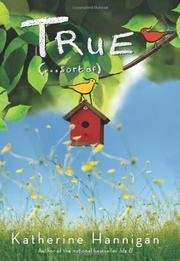 and sometimes I seek out the author. More than 10 years ago, when I was still working in the bookstore, I read Ida B. by Katherine Hannigan, and fell instantly in love with the spunky and imaginative girl at the centre of the story. True (…sort of) was published in 2011 (Greenwillow Books), but the book only found me last month…on the shelves of a local bookstore. Haven’t read the book yet, but it looks terrific. Here’s a short clip of Ms Hannigan discussing True (…sort of).
and sometimes I seek out the author. More than 10 years ago, when I was still working in the bookstore, I read Ida B. by Katherine Hannigan, and fell instantly in love with the spunky and imaginative girl at the centre of the story. True (…sort of) was published in 2011 (Greenwillow Books), but the book only found me last month…on the shelves of a local bookstore. Haven’t read the book yet, but it looks terrific. Here’s a short clip of Ms Hannigan discussing True (…sort of).
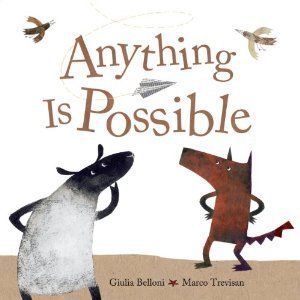 A bird-watching sheep thinks to himself, “How lucky they are! They can choose how they look at things: from far away, from up close, or from somewhere in between.” This is an unusual way of looking not only at birds, but at the idea of possibility. Theoretically, all of us can choose our perspective, but as if often the case, we are overwhelmed by self-limiting thoughts. In Anything is Possible (Giulia Belloni/Marco Trevisan, Owl Kids 2013) a determined sheep is prepared to do anything to make his dream of flying come true. Wolf, on the other hand, is full of doubt, but eventually helps the sheep devise a plan, actually many plans, for his flying machine. When it finally works, it is a marvel of design and kid-like imagination. Italian illustrator Marco Trevisan takes a multimedia-collage approach to the illustration, using scraps of mathematical figures, fabrics, and newspaper clippings to build the machine, while relying on paint and pen for the characters. Anything is Possible humourously celebrates imagination, perseverance, and the courage to dream big. Listen to the sheep (but definitely get help from the wolf.) Just a note, the translator of Anything is Possible is William Anselmi, a fellow Edmontonian and a Professor of Italian Studies at the University of Alberta. Yay homey!
A bird-watching sheep thinks to himself, “How lucky they are! They can choose how they look at things: from far away, from up close, or from somewhere in between.” This is an unusual way of looking not only at birds, but at the idea of possibility. Theoretically, all of us can choose our perspective, but as if often the case, we are overwhelmed by self-limiting thoughts. In Anything is Possible (Giulia Belloni/Marco Trevisan, Owl Kids 2013) a determined sheep is prepared to do anything to make his dream of flying come true. Wolf, on the other hand, is full of doubt, but eventually helps the sheep devise a plan, actually many plans, for his flying machine. When it finally works, it is a marvel of design and kid-like imagination. Italian illustrator Marco Trevisan takes a multimedia-collage approach to the illustration, using scraps of mathematical figures, fabrics, and newspaper clippings to build the machine, while relying on paint and pen for the characters. Anything is Possible humourously celebrates imagination, perseverance, and the courage to dream big. Listen to the sheep (but definitely get help from the wolf.) Just a note, the translator of Anything is Possible is William Anselmi, a fellow Edmontonian and a Professor of Italian Studies at the University of Alberta. Yay homey!
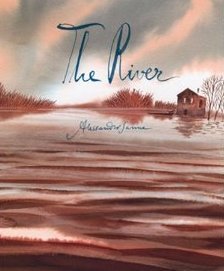 Another gorgeous book from Enchanted Lion Books, The River (Alessandro Sanna, 2014) is a paean to the passage of time and the quiet observation of nature. Painted in washes of translucent watercolour, Sanna captures the changing light of a landscape in transition. While there is some narrative, from awakening spring to winter’s slumber, it is the illustrations that tell the story. Painted in four-panel vignettes, every scene of this exceptional and expansive book has the plein air immediacy of an Impressionist, but with respectful allowances for the interactions between paper and watercolour. “The images flow out of me without a precise order in mind and every time a new page appeared I felt as if I had brought an already formed image into the world.” The River is an artist’s sketchbook, a naturalist’s diary, and a writer’s journal. It must be seen, and treasured.
Another gorgeous book from Enchanted Lion Books, The River (Alessandro Sanna, 2014) is a paean to the passage of time and the quiet observation of nature. Painted in washes of translucent watercolour, Sanna captures the changing light of a landscape in transition. While there is some narrative, from awakening spring to winter’s slumber, it is the illustrations that tell the story. Painted in four-panel vignettes, every scene of this exceptional and expansive book has the plein air immediacy of an Impressionist, but with respectful allowances for the interactions between paper and watercolour. “The images flow out of me without a precise order in mind and every time a new page appeared I felt as if I had brought an already formed image into the world.” The River is an artist’s sketchbook, a naturalist’s diary, and a writer’s journal. It must be seen, and treasured.
Judith Kerr wrote a famous book 35 years ago that I had never read, or barely heard of, until very recently. The Tiger Who Came to Tea somehow passed me by, in spite of my many years as a bookseller and lifelong collector of picture books. I know. BIG. HOLE. (I have a few of them.) Kerr is much better known in the UK, I believe, than in North America, but nevertheless it’s a darn  shame it took so long to meet this incredibly presumptuous, and loveable tiger. With the approach of her 90th birthday last year, there was a lot of press about Ms Kerr, whose parents spirited her and her brother out of Germany on the eve of Hitler’s election in 1933. It was in these articles that I became acquainted, and to a lesser extent, reacquainted with her life and work. Enthralled, I purchased Judith Kerr’s Creatures: A Celebration of Her Life and Work (HarperCollins, 2013) at the same time I brought home the special gift edition of The Tiger Who Came to Tea. It is impossible to not to love Kerr’s friendly and funny illustrations, especially the oversized tiger, helping himself to EVERYTHING in the house. No one questions the presence of the tiger, or the fact that he can talk. On the contrary, there is a very casual acceptance of the fantastic, and certainly Judith Kerr had a fantastical, and at times, very dangerous childhood. Kerr went on to write many other books, including When Hitler Stole Pink Rabbit, about her actual experiences in Nazi Germany, which I will soon read, but for now, I am basking in the charm of a teatotalling tiger. Better late than never.
shame it took so long to meet this incredibly presumptuous, and loveable tiger. With the approach of her 90th birthday last year, there was a lot of press about Ms Kerr, whose parents spirited her and her brother out of Germany on the eve of Hitler’s election in 1933. It was in these articles that I became acquainted, and to a lesser extent, reacquainted with her life and work. Enthralled, I purchased Judith Kerr’s Creatures: A Celebration of Her Life and Work (HarperCollins, 2013) at the same time I brought home the special gift edition of The Tiger Who Came to Tea. It is impossible to not to love Kerr’s friendly and funny illustrations, especially the oversized tiger, helping himself to EVERYTHING in the house. No one questions the presence of the tiger, or the fact that he can talk. On the contrary, there is a very casual acceptance of the fantastic, and certainly Judith Kerr had a fantastical, and at times, very dangerous childhood. Kerr went on to write many other books, including When Hitler Stole Pink Rabbit, about her actual experiences in Nazi Germany, which I will soon read, but for now, I am basking in the charm of a teatotalling tiger. Better late than never.
 Also in the retro vein, I picked up a copy of Wanda Gag’s Millions of Cats (Putnam, 1928.) I love her work, and like Judith Kerr, Wanda Gag led a fascinating life. I did read this book when I was a kid but had largely forgotten it until the publication of The Fairy Tales of the Brothers Grimm, which included Gag’s illustrations for The Fisherman and His Wife, piqued my appetite for more of her distinctive, black and white illustrations. In fact, I plan to collect all of the Gag oeuvre some day, but for now, the story of one cat out of millions will do.
Also in the retro vein, I picked up a copy of Wanda Gag’s Millions of Cats (Putnam, 1928.) I love her work, and like Judith Kerr, Wanda Gag led a fascinating life. I did read this book when I was a kid but had largely forgotten it until the publication of The Fairy Tales of the Brothers Grimm, which included Gag’s illustrations for The Fisherman and His Wife, piqued my appetite for more of her distinctive, black and white illustrations. In fact, I plan to collect all of the Gag oeuvre some day, but for now, the story of one cat out of millions will do.
Lastly, The Mischievians (Antheneum Books, 2013) by the great William Joyce. In recent years, Joyce has devoted his talents to unraveling the back stories of childhood mythological figures, including the Tooth Fairy, Santa Claus, and The Man in the Moon in a series called The Guardians of Childhood. With The Mischievians, Joyce looks not at the heroes, but the rascals – the tiny mayhem makers of a kid’s life, such as the Homework Eater, the Giggler, and my personal favourite, the booger Dangler. Told in the form of a Q & A with Dr. Maximilian Fortisque Robinson Zooper (a typical Joycean invention), The Mischievians is a blast, with loads of humour and wonderful, cheeky art. I will admit to a preference for vintage Joyce, but this imaginative new direction in Joyce’s Moonbotian empire is still thrillingly original. (And beautiful, of course.)
That’s the last of the books that have come my way since January, although it’s entirely possible that I’ve missed a few. The next posting of Shelf Landings will have far fewer books, which is not only a statement of fact but also a wimpery sort of command. I’ve got to slow down! This collection of 19 books represents the books that are physically in my possession and does not include all the books that have tempted me these last few months, nor does it include the books I actually did review. The wish list is long, and for that I thank the authors, illustrators, publishers, bookstores, and fellow bloggers who continue to inspire me with their creative passions. For gods sake, stop it!

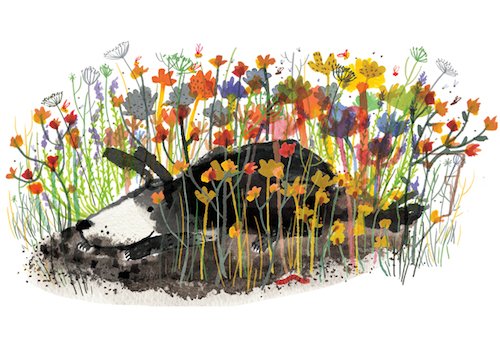
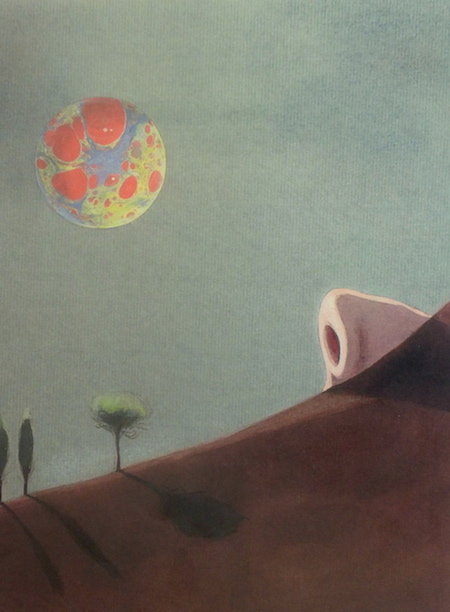
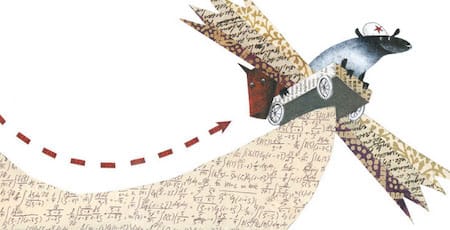
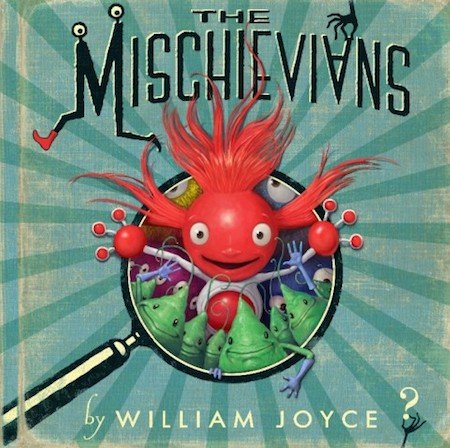

I think I like this new feature of yours. Thankyou for describing so many titles I had never heard of before!
I’m glad you like it. Shelf Landings will be a semi-regular player, but it is only the tip of the iceberg. SO many good books out there!
Thank you for this! I was in such a reading rut with my kids. I got The Fly, the Bugs in a Blanket, and Time for Bed Fred from the library, and my 4 yr old is upset that we are only borrowing them. He and my 2 yr old are OBSESSED with The Fly.
Yes, you can never go wrong with bugs! Glad to hear your kids are enjoying the books. Looking forward to the upcoming books in the Disgusting Critters series.
Oh man. You just increased my list a lot! There are not enough bookshelves in the world. Love the brief highlighting, but look forward to hearing more about some of them.
I will look for these at the library! Always glad to know of new books to read to the little one. If they are to be read a gazillion times over, they NEED to be good for mummy too! Looking forward to this new feature of your Shelf Landings.
Thanks Monica! I already have a few new books to add to my next Shelf Landings. I always think I’m done, and then some little gem comes along…